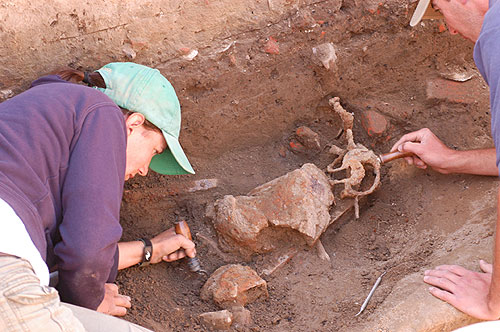
Posted on 05/09/2007 5:46:31 PM PDT by blam
Sword, armor found buried inside remains of James Fort

Archaeologists Mary Anna Richardson, left, and Luke Pecoraro carefully begin excavating a potential cache of arms and armor that so far includes a broad sword with a basket hilt and blade, armor that protects the thigh and a rapier hilt, discovered recently at Historic Jamestowne. PHOTO BY MICHAEL LAVIN / APVA PRESERVATION VIRGINIA
By DIANE TENNANT, The Virginian-Pilot
© May 9, 2007 | Last updated 1:49 PM May. 9
JAMESTOWN – A cache of armor from the early 1600s has been discovered by archaeologists excavating a trash pit inside the remains of James Fort.
Queen Elizabeth II viewed the objects during her visit Friday, observing a broadsword with a basket hilt, an iron pole, the hilt from a rapier and armor pieces that would have protected the thigh.
“It may be like the tip of an iceberg,” said William Kelso, director of archaeology for APVA Preservation Virginia, in a press release. “We’ll see as we uncover more of it in the next few days.”
The armor was partly uncovered last week, about 3 feet below what would have been ground level in the early 1600s. The pit itself is 19 feet square. Because the layers slump toward the center, archaeologists think it may have been a well that went bad, and was then used for trash.
Glass trade beads, baubles, chess pieces, iron objects and pottery shards have also been found in the pit. Indian artifacts found there include a grinding stone, a bone needle and shell beads. Animal remains include oysters, sturgeon, crab claws, fish, bird, turtle, deer and goat.
Kelso speculated that it could be the first well dug by colonist John Smith in 1608-09. Archaeologists can date it by the artifacts, which include a coin dated 1613 found near the top, and by the fact that the pit is under the foundation of a building constructed in 1617.
Furthermore, historical accounts mention that military equipment was buried in the fort in June 1610, when the colonists decided to abandon Jamestown after the “Starving Time” winter. The day after they left, they were forced to return by Lord De La Warre, whose supply fleet coming up the James River met the dispirited colonists coming down.
Archaeologists also plan to work on a site this summer that they hope contains remnants of the first church built for the colony.
How interesting!
I worked one summer as an interpreter on board both the Godspeed and Susan Constant (had to learn every line and every position on board each ship). We sailed them up and down the James and into Hampton Roads. My Bro-in-Law and his two sons did the same thing a few years later. Jamestown is in my family history too. One of the first graves positively identified belongs to an ancestor. We are only an hour or so from there
The Jamestown settlers came to Virginia for two reasons, gold and a route to the west. The Pilgrims came for religious reasons. They were heading for Virginia, but they ended up in Massachusetts. Interestingly enough the spot where they settled was discovered in 1614 by John Smith (from Jamestown).
Oh my. Such sadness in your family. Yes, I love genealogy but haven’t had time for it much with kiddoes in school.
It does seem like that, doesn’t it? You might want to take a peak in the NC and MD archives. Many times, VA families either came from these areas or had relatives there early on and they have better records then we do.
Colonials did not sleep lying all the way down like we do today. They slept with their heads and shoulders up, mostly due to respiratory ailments. They didn’t have our medicines and it made it easier breathing at night.
I used to buy a lot of genealogy books on ebay, but not as much recently. I’ve also found that a lot of the genealogies posted on the internet are wrong. What I do find useful is the digitizing of records like land records, etc.
Thank you.
Disclaimer: Opinions posted on Free Republic are those of the individual posters and do not necessarily represent the opinion of Free Republic or its management. All materials posted herein are protected by copyright law and the exemption for fair use of copyrighted works.